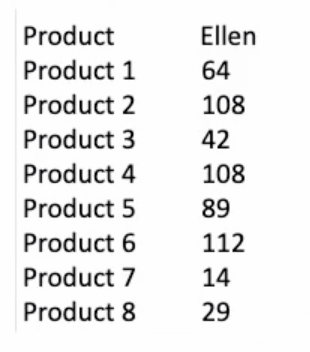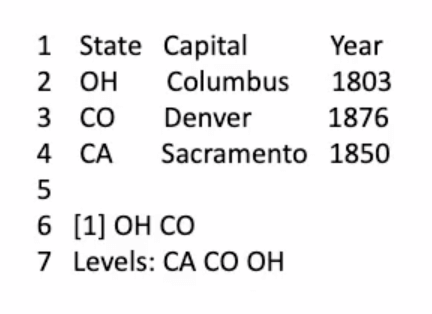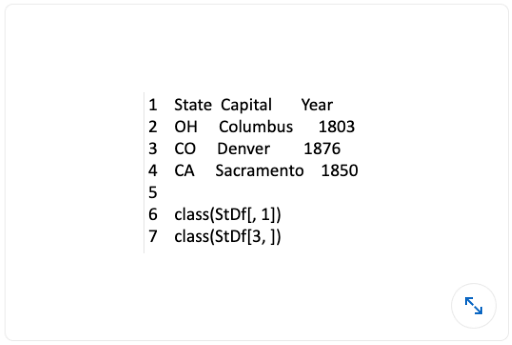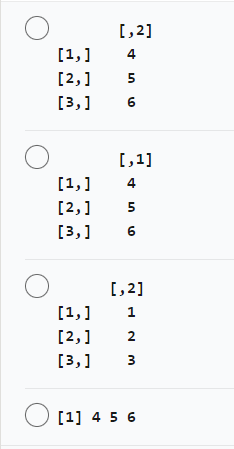Here, We see R LinkedIn Skill Assessment Answer. This assessment test consists of 15-20 MCQs to demonstrate your knowledge of your selected skills. MCQs come from different topics – R Data Structures, Data Management, Functions, Operators, and Statistics..
List of all LinkedIn Skills Assessment Answer

R LinkedIn Skill Assessment Answer
Q1. How does a matrix differ from a data frame?
- A matrix may contain numeric values only.
- A matrix must not be singular.
- A data frame may contain variables that have different modes.✔
- A data frame may contain variables of different lengths.
Q2. What value does this statement return?
unclass(as.Date("1971-01-01"))- 1
- 365✔
- 4
- 12
Q3. What do you use to take an object such as a data frame out of the workspace?
- remove()✔
- erase()
- detach()
- delete()
Q4. Review the following code. What is the result of line 3?
xvect<-c(1,2,3)
xvect[2] <- "2"
xvect
- [1] 1 2 3
- [1] “1” 2 “3”
- [1] “1” “2” “3”✔
- [1] 7 9
Q5. The variable height is a numeric vector in the code below. Which statement returns the value 35?
- height(length(height))
- height[length(height)]✔
- height[length[height]]
- height(5)
Q6. In the image below, the data frame is named rates. The statement sd(rates[, 2]) returns 39. How does R regard Ellen’s product ratings?

- sample with replacement
- population
- trimmed sample
- sample✔
Q7. Which choice does R regard as an acceptable name for a variable?
- Var_A!
- \_VarA
- .2Var_A
- Var2_A✔
Q8. What is the principal difference between an array and a matrix?
- A matrix has two dimensions, while an array can have three or more dimensions.✔
- An array is a subtype of the data frame, while a matrix is a separate type entirely.
- A matrix can have columns of different lengths, but an array’s columns must all be the same length.
- A matrix may contain numeric values only, while an array can mix different types of values.
Q9. Which is not a property of lists and vectors?
- type
- length
- attributes
- scalar✔
Q10. In the image below, the data frame on lines 1 through 4 is named StDf. State and Capital are both factors. Which statement returns the results shown on lines 6 and 7?

- StDf[1:2,-3]
- StDf[1:2,1]✔
- StDf[1:2,]
- StDf[1,2,]
Q11. Which function displays the first five rows of the data frame named pizza?
- BOF(pizza, 5)
- first(pizza, 5)
- top(pizza, 5)
- head(pizza, 5)✔
Q12. You accidentally display a large data frame on the R console, losing all the statements you entered during the current session. What is the best way to get the prior 25 statements back?
- console(-25)
- console(reverse=TRUE)
- history()
- history(max.show = 25)✔
Q13. d.pizza is a data frame. It’s a column named temperature contains only numbers. If you extract temperature using the [] accessors, its class defaults to numeric. How can you access temperature so that it retains the class of data.frame?
> class( d.pizza[ , "temperature" ] )
> "numeric"
- class( d.pizza( , “temperature” ) )
- class( d.pizza[ , “temperature” ] )
- class( d.pizza$temperature )
- class( d.pizza[ , “temperature”, drop=F ] )✔
Q14. What does c contain?
a <- c(3,3,6.5,8)
b <- c(7,2,5.5,10)
c <- a < b
- [1] NaN
- [1] -4
- [1] 4 -1 -1 2
- [1] TRUE FALSE FALSE TRUE✔
Q15. Review the statements below. Does the use of the dim function change the class of y, and if so what is y’s new class?
> y <- 1:9
> dim(y) <- c(3,3)
- No, y’s new class is “array”.
- Yes, y’s new class is “matrix”.✔
- No, y’s new class is “vector”.
- Yes, y’s new class is “integer”.
Q16. What is mydf$y in this code?
mydf <- data.frame(x=1:3, y=c("a","b","c"), stringAsFactors=FALSE)- list
- string
- factor
- character vector✔
Q17. How does a vector differ from a list?
- Vectors are used only for numeric data, while lists are useful for both numeric and string data.
- Vectors and lists are the same thing and can be used interchangeably.
- A vector contains items of a single data type, while a list can contain items of different data types.✔
- Vectors are like arrays, while lists are like data frames.
Q18. What statement shows the objects in your workspace?
- list.objects()
- print.objects()
- getws()
- ls()✔
Q19. What function joins two or more column vectors to form a data frame?
- rbind()
- cbind()✔
- bind()
- coerce()
Q20. Review line 1 below. What does the statement in line 2 return?
1 mylist <- list(1,2,"C",4,5)
2 unlist(mylist)
- [1] 1 2 4 5
- “C”
- [1] “1” “2” “C” “4” “5”✔
- [1] 1 2 C 4 5
Q21. What is the value of y in this code?
x <- NA
y <- x/1
- Inf
- Null
- NaN
- NA✔
Q22. Two variables in the mydata data frame are named Var1 and Var2. How do you tell a bivariate function, such as cor.test, which two variables you want to analyze?
- cor.test(Var1 ~ Var2)
- cor.test(mydata$(Var1,Var2))
- cor.test(mydata$Var1,mydata$Var2)✔
- cor.test(Var1,Var2, mydata)
Q23. A data frame named d.pizza is part of the DescTools package. A statement is missing from the following R code and an error is therefore likely to occur. Which statement is missing?
library(DescTools)
deliver <- aggregate(count,by=list(area,driver), FUN=mean)
print(deliver)
- attach(d.pizza)✔
- summarize(deliver)
- mean <- rbind(d.pizza,count)
- deliver[!complete.cases(deliver),]
Q24. How to name rows and columns in DataFrames and Matrices F in R?
- data frame: names() and rownames() matrix: colnames() and row.names()
- data frame: names() and row.names() matrix: dimnames()✔
- data frame: colnames() and row.names() matrix: names() and rownames()
- data frame: colnames() and rownames() matrix: names() and row.names()
Q25. Which set of two statements-followed by the cbind() function-results in a data frame named vbound?
- A
v1<-list(1,2,3)
v2<-list(c(4,5,6))
vbound<-cbind(v1,v2)- B
v1<-c(1,2,3)
v2<-list(4,5,6))
vbound<-cbind(v1,v2)- C✔
v1<-c(1,2,3)
v2<-c(4,5,6))
vbound<-cbind(v1,v2)- none
Q26. ournames is a character vector. What values does the statement below return to Cpeople?
Cpeople <- ournames %in% grep("^C", ournames, value=TRUE)- records where the first character is a C
- any record with a value containing a C
- TRUE or FALSE, depending on whether any character in ournames is C
- TRUE and FALSE values, depending on whether the first character in an ournames record is C✔
Q27. What is the value of names(v[4])?
v <- 1:3names(v)<-c("a","b","c")
v[4]<-4- “”✔
- d
- NULL
- NA
Q28. Which of the following statements doesn’t yield the code output below? Review the following code. What is the result of line 3?
x <-c(1,2,3,4)
Output:[1]234- x[c(2, 3, 4)]
- x[-1]
- x[c(-1, 0, 0, 0)]
- x[c(-1, 2, 3, 4)]✔
Q29. Given DFMerged <- merge(DF1, DF2) and the image below, how many rows are in DFMerged?

- 6
- 9
- 3
- 0✔
Q30. What does R return in response to the final statement?
x<-5:8names(x)<-letters[5:8]
x- e f g h “5” “6” “7” “8”
- 5 6 7 8
- e f g h
- e f g h 5 6 7 8✔
Q31. How do you return “October” from x in this code?
x<-as.Date("2018-10-01")- attr()
- months(x)✔
- as.month(x)
- month(x)
Q32. How will R respond to the last line of this code?
fact<-factor(c("Rep","Dem","Dem","Rep"))
fact
[1] Rep Dem Dem Rep
Levels: Rep Dem
fact[2]<-"Ind"- >
- [,2]Ind
- invalid factor level, NA generated✔
- Ind
Q33. What does R return?
StartDate<- as.Date("2020/2/28")
StopDate<- as.Date("2020/3/1")
StopDate-StartDate
- “1970-01-02”
- time difference of one day
- time difference of two days✔
- error in x-y: non-numeric argument to binary operator
Q34. What does the expression mtrx * mtrx do?
> mtrx <- matrix(c(3,5,8,4), nrow=2,ncol=2,byrow=TRUE)> newmat <- mtrx * mtrx
- it transposes the matrix
- it premultiplies the current netwmat row by the newmat column.
- it returns the results of a matrix multiplication
- It squares each cell in mtrx✔
> newmat
[,1][,2][1,]925[2,]6416# The `%*%` operator gives matrix multiplication> mtrx %*% mtrx
[,1][,2][1,]4935[2,]5656Q35. Which function in R combines different values into a single object?
- connect()
- concat()
- contact()
- c()✔
Q36. Which file contains settings that R uses for all users of a given installation of R?
- Rdefaults.site
- Renviron.site
- Rprofile.site✔
- Rstatus.site
Q37. If mdf is a data frame, which statement is true ?
- ncol(mdf) equals length(mdf).✔
- The number of rows must equals the number of columns.
- The legnth of any column in mdf may differ from any other column in mdf
- All columns must have the same data type.
Q38. A list can contain a list as an element. MyList has five columns, and the third column’s item is a list of three items. How do you put all seven values in MyList into a single vector?
- vector(MyList, length = 7)
- coerce(MyList, nrows = 1)
- unlist(MyList)✔
- coerce(MyList, nrows = 7)
Q39. Which strings could be returned by the function ls(path = “^V”)?
- ANOVAData, anovadata
- VisitPCA, VarX✔
- VisitPCA, varx
- Xvar, Yvar
Q40. StDf is a data frame. Based on this knowledge, what does this statement return?
StDf[,-1]- all but the first row and first column of StDf
- all but the final column of StDf
- all but the first column of StDf✔
- only the first column of StDf
Q41. Which statement enables you to interactively open a single file?
- file.list()
- file.select()
- file.choose()✔
- file.open()
Q42. How are these data types alike: logical, integer, numeric, and character?
- Each is a type of data frame.
- Each is a type of atomic vector.✔
- Each is a type of complex vector.
- Each is a type of raw vector.
Q43. What does the MyMat[ ,3] subsetting operation return for this code?
MyMat = matrix(c(7,9,8,6,10,12),nrow=2,ncol=3, byrow =TRUE)- A
[ ,3]
[1, ] 8
[2, ] 12
- B✔
[1] 8 12- C
[1] 10 12
- D
[ ,3]
[1, ] 10
[2, ] 12
Q44. What does the function power.anova.test return?
- the probability of making a Type I error
- the probability of not making a Type II error✔
- the probability of making a Type II error
- the probability of not making a Type I error
Q45. Review the statement below. What is the effect of covariate:factor on the analysis?
result <- lm(outcome ~ covariate + factor + covariate:factor, data = testcoef)- It forces the intercepts of the individual regressions to zero.
- It calls for the effect of the covariate within each level of the factor.✔
- It calls for the effect of each variable from the covariate to factor in the test.
- It forces the covariate to enter the equation before the factor levels.
Q46. A variable whose type is numeric can contain which items?
- integers and real values
- integers, real, and raw values
- real values only✔
- integers, real, and logical values
Q47. What is the legitimate name of a data class in R?
- property
- integer✔
- number
- variant
Q48. How do you extract the values above the main diagonal from a square matrix named Rmat?
- Rmat[upper.tri(Rmat)]✔
- upper.triangular(Rmat)
- upper.tri(Rmat)
- upper.diag(Rmat)
Q49. x is a vector of type integer, as shown in line 1 below. What is the type of the result returned by the statement > median(x)?
x <- c(12L, 6L, 10L, 8L, 15L, 14L, 19L, 18L, 23L, 59L)- numeric
- integer
- single
- double✔
Q50. A list named a is created using the statement below. Which choice returns TRUE?
a <- list("10", TRUE, 5.6)- is.list(a[1])✔
- is.numeric(a[1])
- is.logical(a[1])
- is.character(a[1])
Q51. How do you obtain the row numbers in a data frame named pizza for which the value of pizza$delivery_min is greater than or equal to 30?
- A
late_delivery <- pizza$delivery_min >=30
index_late <- index(late_delivery)
index_late
- B
late_delivery <- pizza$delivery_min >=30
rownum_late <- rownum(late_delivery)
rownum_late
- C✔
late_delivery <- pizza$delivery_min >=30
which_late <- which(late_delivery)
which_late- D
late_delivery <- pizza$delivery_min >=30
late <- piza$late_delivery
pizza$late
Q52. Which function returns [1] TRUE FALSE TRUE?
indat <- c("Ash Rd","Ash Cir","Ash St")- grepl(“[Rd|Ave|Dr|St]”, indat)
- grepl(“Rd|Ave|Dr|St”, indat)✔
- grepl(“Rd,Ave,Dr,St”, indat)
- grepl(“[Rd],[Ave],[Dr],[St]”, indat)
Q53. Which statement returns the fourth row of a data frame named fish?
- fish[4, ]✔
- fish( ,4)
- fish(4, )
- fish{4, }
Q54. What is the value of csum?
a <- c(1.2, 2, 3.5, 4)
b <- c(1.2, 2.2, 3.5, 4)
csum <-sum(a == b)
- 8
- 3✔
- 0.2
- 21.6
Q54. A list named a is created using the statement below. Which choice returns TRUE?
a <- list("10", TRUE, 5.6)
- is.list(a[1])✔
- is.numeric(a[1])
- is.logical(a[1])
- is.character(a[1])
Q55. What is the result of these three lines of code?
vect1 <-c(1:4)
vect2 <-c(1:2)
vect1 * vect2
- [1] 1 4 3 8✔
- ERROR
- [1] 1 2 3 4 1 2
- [1] 1 2 3 4 2 4 6 8
Q56. Which choice returns [1] “2019-09-28”?
- format(as.POSIXct(“Sep-28-2019 07:54:31 AM”,format=’%b%d%Y’))
- as.POSIXlt(“Sep-28-2019 07:54:31 AM”,format=’%b-%d-%Y’)
- as.POSIXct(“Sep-28-2019 07:54:31 AM UTC”)
- format(as.POSIXct(“Sep-28-2019 07:54:31 AM UTC”,format=’%b-%d-%Y’))✔
Q57. The variable potus is a character vector, as shown in line 1 below. Wich statement returns the results shown?
1 potus <-c("GHW Bush","Clinton","GW Bush","Obama")
Results:[1]"GHW BUsh""Clinton""Obama"- potus[-“GW Bush”]
- potus[1:2 4]
- potus[-3]✔
- potus[1,2,4]
Q58. A data frame contains two factor -fact1 and fact2- and a numerical outcome variable. Which statement returns results that do NOT include an interaction term?
- anova(lm(outcome ~ fact1 : fact2))✔
- anova(lm(outcome ~ fact1 * fact2))
- anova(lm(outcome ~ fact1 + fact2))
- anova(lm(outcome ~ fact1 + fact2 + fact1 : fact2))
Q59. Review line 1 below. What does the statement on line 2 return?
1 myvect <-c(-2,-1,0)2as.logical(myvect)- [1]-2 -1 0
- [1]TRUE TRUE FALSE✔
- [1]FALSE FALSE TRUE
- [1]NA NA NA
Q60. Which option setting can cause difficulty if you want to add to a variable’s possible values after you have designed an object’s initial data structure?
- ()OPTIONS(colnames(x)<-NULL)
- ()OPTIONS(max.print=5)
- ()OPTIONS(continue=”… “,
- ()OPTIONS(stringAsFactors=TRUE✔
Q61. In the image below, the data frame on lines 1 through 4 is named StDf. StDf contains no factors. Why does the statement on line 6 return “character” while the statement on line 7 returns “data.frame”?

- Each value in the first row is a character value, but the values in the third column include both character and numeric values.
- By specifying the final row, 3, and no column specified, StDf[3, ] calls for the complete structure.
- Columns in a data frame are vectors generally containing a single type of data. Rows in a data frame are lists, but they belong to a structure that has multiple rows: the data frame.✔
- Each value in the first column is a character value, but the values in the third row include both character and numeric values.
Q62. Review line 1. What does the statement on line 3 return?
mtrx <- matrix(1:6,3,2)
mtrx[,-1]
-
-
-
- [1] 4 5 6✔
Q63. Why does sum(!is.na(pizza$week)) return the number of rows with valid, non-NA values in the column named week?
- The exclamation point in !is.na(pizza$week) reverses the meaning of the test it precedes.✔
- !is.na(pizza$week) counts the number of NA values in the column.
- !is.na(pizza$week) returns a vector of TRUE/FALSE values, in which TRUE is treated as a 0 and FALSE as a 1.
- !is.na(pizza$week) counts the number of non-missing values in the column.
Q64. How do you get documentation of an installed and loaded R package named dplyr and packages with dplyr as an alias?
- help(dplyr)
- ? dplyr
- ?? dplyr✔
- Press the F1 key.
Q65. In the image below, the data frame named iris includes a numeric vector named Petal.Length. Do the functions labeled Pair 1 and Pair 2 return the same information?

- No, both the length and the class of the returned structures are different.✔
- Yes, both pairs of statements return an object with the same length and class.
- No, the length is the same but the class is different.
- No, the class is the same but the length is different.
Q66. The _ for R is the main feature that makes it different from the original S language.
- closure rules
- scoping rules✔
- environment rules
- None of the above
Q67. Which of the following is a base package for R programming?
- tools✔
- util
- lang
- All of the above